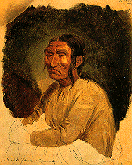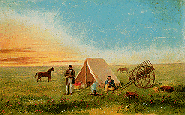


|
Paul Kane's Great Nor-West.
Diane Eaton and Sheila Urbanek.
Vancouver: UBC Press, 1995. 176pp, cloth, $39.95.
ISBN: 0-7748-0538-2.
Grades 10 - 13 / Ages 14 - Adult.
Review by T.S. Casaubon.
****/4
|
excerpt:
On his return to Fort Vancouver two months later, Kane stopped at
Cowlitz and went straight to the lodge of his old friend Kiscox. To his
surprise, he found the chief and family that had once welcomed him so
hospitably cool and peculiarly distant, the children even running away as
he approached. After some time, Kiscox asked him if he had made a
portrait of a woman on his last visit. `I said that I had,' Kane writes,
`and mentioned her name, Caw-wacham . . . A dead silence ensued, nor could
I get the slightest answer to my enquiries.' On leaving the lodge Kane
met a mixed-blood Indian who told him that Caw-wacham had taken sick and
died and that he, Kane, was believed to have caused her death. Fearing
reprisal, Kane `immediately procured a canoe, and started for Fort
Vancouver, down the river, paddling all night, well knowing the danger
that would result from [his] meeting with any of her relations.'
Paul Kane (1810-1871) was a Toronto-born, and largely self-taught, artist
who resolved early to make a lasting record of North American Indians and
their traditional way of life. The central event of his career was a
journey of two-and-half years through the wilderness, from the Great
Lakes, through the Red River settlement (where he saw and painted one of
the last great buffalo hunts), the Rockies, and into the Pacific
Northwest.

But to gain the cooperation of the Hudson's Bay Company, which
essentially governed what is now Canada west of the Great Lakes, he had
to first establish himself as a fit traveller. That meant Kane had to
show Hudson's Bay governor George Simpson that he could keep up with the
company voyageurs on the first legs of the fur route into the northwest.
Kane did better than pass the test -- he not only gained the protection
of the company, but by the end of his adventures was leading one of its
daunting winter expeditions.
All along Kane's great trip he made sketches and watercolours
whenever he could: landscapes, pictures of forts and towns, and most importantly, portraits
of the natives he met -- portraits that gained him a reputation as a medicine man. Most of his
later career was to consist of working up striking paintings based on
those field sketches and on the native artifacts he gathered on the trip.
In this later work Kane was unable to resist bending the images he had
captured on his travels to fit the classical tastes of the time, but his
field work had unusual freshness and accuracy.
Kane also kept a journal of his travels, and later wrote them up
(with some help and embellishment) as Wanderings of an Artist among
the Indians of North America . . . , a classic of Canadian
travel writing (and a best-seller in its time). In both the sketches and
journal, Kane fulfilled his goal of making an important historical and
anthropological record of ways of life that were already starting to
disappear.

Diane Eaton is a Vancouver freelance writer and the author of
Canada: A Nation Unfolding (1994); Sheila Urbanek is an art
historian ``with a long-standing interest in the art and culture of the
pacific Northwest." Together, in Paul Kane's Nor-West, they
have brought Kane's great trip to life for the modern reader, providing a
meticulous and clearly written account that relies heavily on Kane's own
words (or those of his ghost-writers) but also gives the background and
context of the journey and of almost everyone Kane encountered. Only
occasionally is a term that might confuse a reader without a good grounding
in history -- like `manifest destiny' -- left unexplained.
There is a slight whiff of political correctness in Eaton and
Urbanek's introduction, in which the authors apologize for sins in their
subject that only a late-twentieth century academic would be likely to
detect, but this is the obligatory defensive incantation of our time --
as forgivable as Kane's later `classical' interpretations of the subjects
of his trip.
So Paul Kane's Nor-West is a fascinating and important
work of travel and adventure that will be especially well suited to
senior students in art, anthropology, or history. Only the stiff price
might deter a purchase, but the book is not a budget production and is
well worth it. The large format allows for an excellent and clear design,
many excerpts from Kane's book and diary in the margins, and plenty of
full-page, often full-colour reproductions of Kane's paintings.
Importantly, Kane's field work is also heavily represented.
In their introduction, Eaton and Urbanek write:
Unfortunately, Kane's works, like the nineteenth-century world he
strove to preserve in pictures and words, have faded from public
attention. . . . his art and prose deserve more attention from a wider
audience.
This book is essentially a rescue mission.
Mission accomplished.
Highly recommended.
T.S. Causabon is a Winnipeg-based freelance writer.
To comment on this title or this review, send mail to cmeditor@mts.net.

Copyright © 1996 the Manitoba Library Association.
Reproduction for personal use is permitted only if this copyright notice
is maintained. Any other reproduction is prohibited without permission.
Published by
The Manitoba Library Association
ISSN 1201-9364

CONTENTS FOR THIS ISSUE |
WELCOME


![]()



![]()
![]()